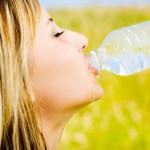Could This Innocent Household Item Be Making Your Butt Bigger Plus Increasing Cancer Risk?

And well they should. According to naturopath Lisa Guy, a recent study from the Yale School of Medicine, published in The Endocrine Society journal, Hormones and Cancer, found that exposure to chemicals such as BPA in the womb can increase a person’s risk of breast cancer later in life. If health risks don’t scare you then you may be interested to know that increased exposure to xenoestrogens goes hand in hand with increased lower body fat storage. Yup. Those pear shaped hips might be genetic in part, but the reality is that your lifestyle says a lot more about your body shape than what your genes do. Through the Biosignature, we know that an excess of synthetic estrogen can result not just in higher risk of breast, prostate, and other cancers, but also plays havoc with a host of other hormonal functions such as fertility and libido. Oh – and while estrogen can increase lower body fat in females (particularly), it also does a swift one on the guys, going hand in hand with aromatisation of testosterone (your body converting testosterone to estrogen), and female-like characteristics such as man boobs. An estrogen imbalance can also make it very tough for you to build lean muscle.
The reason xenoestrogens affect your health so much is that molecularly they are so similar to human estrogen that your body cannot tell the difference. The more ‘fake’ estrogens you are exposed to, the more of an estrogen imbalance you can unwittingly create hormonally.
but they’re everywhere!
Xenoestrogens are rife not only in plastics and other household items, but also in pesticides, herbicides, and fungicides (which is just one reason I always advocate organic food).
And let’s face it. Environmental chemicals such as pesticides are everywhere. Here in Australia, planes are sprayed externally with pesticides as soon as they land on the tarmac. “Welcome to Australia, and please accept this nice gift of synthetic estrogen while you’re here. Sorry, no refusals”. The truth is that you can never fully control your environment, which makes it all the more important, of course, that you do take charge where possible.
Offender number one: the humble water bottle
In the spotlight at the moment is the humble water bottle. While many doctors will tend to take the more PC approach (“the evidence is not clear either way so let’s just wait and see … kinda like we did with lead. And asbestos. Oh well; I’m sure it will all be fine!”) alternative health practitioners the world over have long warned clients and family of the dangers of too much plastics exposure.
BPA (which hardens plastic) is found most commonly in water bottles, but also baby bottles (and baby toys, hence the brilliant book Slow Death By Rubber Duck), most plastic kitchenware, and is also used to line cans of tinned food as well as many milk and juice containers. And whilst it’s true that heat combined with plastic causes the most toxic damage, the truth is that anything housed in plastic will be absorb xenoestrogens in some amount. In fact – and this one freaked me out big time – if you’re thinking that drinking bottled water is not so bad as long as you don’t let the water heat up, think again. According to a client of mine who works for Coca-Cola, all bottled water (and, I’m guessing, all bottled beverages) is hot poured. They do this to kill bacteria. Awesome.
so what’s a health conscious small-booty-lovin’ person to do?
Well, like many aspects of healthy living, it’s going to take a little change and effort. But really? Nothing that difficult considering the outstanding difference it may make to your health.
- Use Pyrex containers for your food, or BPA free plastic.
- Use BPA free water bottles with filtered water from home, or stainless steel.
- If you can’t find ‘BPA free’, know that you should avoid the recycling number 7, or the letters “PC”. The labels 1, 2, and 4 are safe.
- For babies and small children use ONLY BPA free bottles, dummies, teething rings, and even toys. Especially bath toys as they are heated up.
- Many chemicals used in skincare and bathing products are xenoestrogen based and may disrupt your endocrine system. To find out what you’re really slathering all over your body visit this useful website.
- The contraceptive pill is one of the most common ways to increase estrogen. You may like to discuss with your doctor the possibility of going to a lower dose pill. I’ve heard it said that many of the fitness models use Yasmin or Yas due to it’s minimal effect on estrogen and increased body fat.
- Avoid chicken because of the hormones? Wrong! I’m happy to say that hormones have not been used in Australia in poultry farming since the 1960’s. This is a myth. If you want to be sure though (and to avoid the effects of a poor diet and pesticides), choose free-range organic poultry only.
final thoughts: big butts and big(ger) boobs
Now I don’t know how you feel about big boobs. Personally, I’m rapt to have my pregnancy-estrogen-boosted chest finally back to its normal flat(ish) self as it’s far more practical for training. Funnily enough, my partner doesn’t really agree with me. Anyway, fortunately or unfortunately as the case may be, it would appear that environmental and nutritional estrogens are causing a significant increase in the average bust size. According to Monash University women’s health specialist Professor Susan Davis the levels of estrogen in women’s bodies is affected by our environment, and those levels are making themselves known in curves everywhere.
Sunday Life magazine journalist Erika Woods writes that “in 1960 the average women’s breast size was 10B in Australia. 10 years ago, it was 12B, (while) today it’s 14C”. And apparently bra manufacturers such as Triumph are trialing sizes as large as a J cup. Yikes! If you’re thinking that this is just because women are bigger overall, you’d be partially correct. A 2005 National Health Survey found that 39% of Aussie women are overweight, and certainly we all know that the average size (now a 14) is far higher than it was a generation or two back. Yet FHM editor Guy Mosel comments that “even women with skinny bodies seem to have over-developed breasts now, which isn’t a shape that used to exist at all”
Could plastics be playing a part? Can we really blame our environment and innocuous household items such as plastic water bottles for our changing body shape and increased health concerns? Or are we just trying to avoid responsibility for poor nutrition and the effects of modern stressful living? I say it’s up to you to decide. But I know where I’m putting my money, and it’s no longer the water bottle vending machine.
Your thoughts?
\

Great article Kat. It is an awesome task removing plastic for your life, but well worth it. I had a coffee with my cousin last week and we went over all the members of our family and extended families who had been effected with cancer. It’s rediculous. I don’t want to make my bum smaller, but I’m keen on avoiding prostate cancer. Cheers
Indeed 🙂
Great article! Very informative!